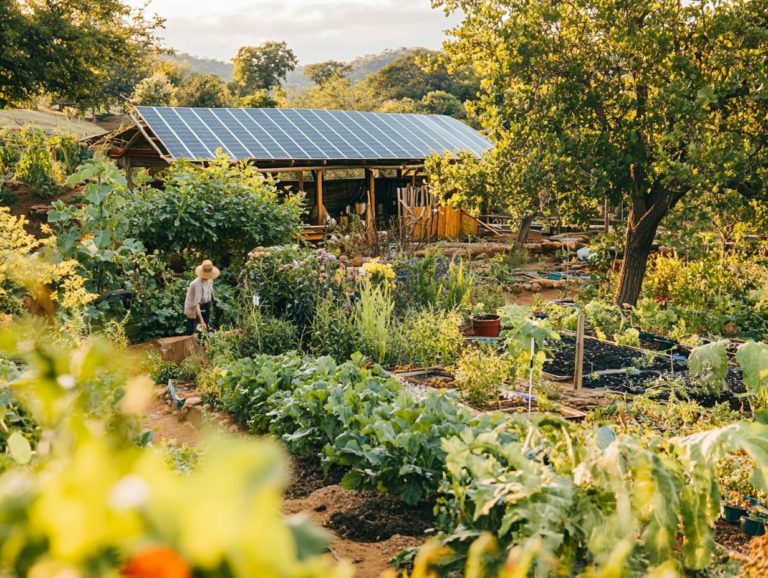How to Attract Beneficial Insects to Your Garden?
In the realm of gardening, it s often the tiniest creatures that wield the greatest influence. Beneficial insects serve as guardians, thwarting pests and boosting the pollination of your plants. Transform your garden into a lush paradise!
This guide will expertly lead you through recognizing these invaluable allies, crafting welcoming habitats for them, and appreciating their unique contributions.
From choosing the right pollinator-friendly plants and flowering herbs to nurturing a harmonious ecosystem, discover the secrets now to transform your garden today!
Contents
- Key Takeaways:
- Understanding Their Role in the Garden
- Identifying and Attracting Beneficial Insects
- Frequently Asked Questions
- What are beneficial insects and why should I attract them to my garden?
- How can I attract beneficial insects to my garden?
- Which plants are best for attracting beneficial insects?
- Can I use pesticides and still attract beneficial insects?
- How do beneficial insects help my garden?
- What are some common beneficial insects and what do they do?
Key Takeaways:

- Understand the important role beneficial insects play in your garden, such as natural pest control and pollination.
- Identify and attract common types of beneficial insects by creating a welcoming habitat through plant selection.
- Attracting beneficial insects can reduce the need for harmful insecticides and promote a healthy, balanced ecosystem.
Understanding Their Role in the Garden
Understanding the role of beneficial insects in your garden is essential for creating a thriving garden environment that flourishes without heavy dependence on chemical control.
These insects like lady beetles, praying mantises, and lacewings not only help manage pest populations but also play an important role in pollination, greatly enhancing the overall health of your garden. Hoverflies and adult flower flies also contribute significantly.
Create a vibrant home for these beneficial insects and watch your garden thrive! By doing so, you can boost your garden’s biodiversity, making it more resilient to pest outbreaks while encouraging a thriving community of beneficial insects.
This approach beautifully complements organic pest control practices and promotes the use of pollinator-friendly plants.
Identifying and Attracting Beneficial Insects
Identifying and attracting beneficial insects to your garden is crucial for enhancing biodiversity and maintaining an ecological balance (the state of equilibrium in nature). Engaging in companion planting (growing different plants together for mutual benefit) can assist in this endeavor.
Beneficial insects like adult flower flies, ground beetles, and lacewings act as your natural allies in the battle against common garden pests. Solitary bees and parasitic wasps also play important roles.
To draw these helpful insects into your space, focus on creating diverse plantings that offer abundant nectar sources and suitable habitats, including wildflowers that attract various insect allies. By incorporating pollinator-friendly plants and flowering herbs, you can significantly boost the presence of beneficial insects, enriching the health and vitality of your garden while attracting butterflies as well.
Common Types and Their Preferred Habitats
Common beneficial insects, like lady beetles, praying mantises, and parasitic wasps, each flourish in specific habitats that support their life cycles and feeding habits.
For instance, lady beetles thrive in gardens infested with aphids, where they eagerly feast on these pests, helping maintain the health of your plants. Praying mantises are typically found in diverse environments such as shrubbery or flower gardens, using their predatory skills to manage a wide array of insects, making them invaluable allies in pest control.
Parasitic wasps prefer gardens where they can find ample hosts for their larvae, ensuring stable populations while effectively keeping pest numbers in check. Trichogramma wasps are known for their efficacy in this role. Solitary bees and butterflies are drawn to vibrant flowering plants, essential for their pollination activities.
By incorporating a variety of plants that cater to these insects’ preferences, including those from the aster family, carrot family, and verbena family, you can create a sanctuary that nurtures these beneficial allies. This ultimately enhances the overall health of your garden ecosystem.
Start your garden transformation today by following these tips and embracing the incredible benefits of beneficial insects!
How to Create a Welcoming Environment

Creating a welcoming environment for beneficial insects is essential for boosting their population in your garden. This helps embrace organic practices that minimize the use of pesticides.
By prioritizing the needs of these helpful insects, you ll cultivate a vibrant habitat that draws in a variety of insect allies, including solitary bees and butterflies. This ultimately aids in effective pest management and healthy plant growth.
Incorporating native plants into your garden is another powerful strategy, as these species tend to be more appealing to your local insect populations, particularly solitary bees and hoverflies. Consider creating small puddles or shallow dishes filled with pebbles and water; these will serve as vital drinking spots for them, further enhancing the habitat for insects.
When you choose organic methods, you re not just helping insects; you re creating a healthier garden! Steering clear of artificial bug sprays and fertilizers not only supports these insects but also promotes long-term soil health and a sustainable garden environment.
By fostering an ecological approach, you ll likely notice an increase in pollinators and pest predators, including lady beetles and lacewings, establishing a balanced ecosystem that flourishes in harmony.
Benefits of Attracting Beneficial Insects
Attracting beneficial insects to your garden offers a wealth of advantages, particularly in the realms of natural pest control and enhanced pollination, which are essential for cultivating a flourishing ecosystem. For tips on attracting these helpful creatures, check out this guide on creating a pollinator-friendly garden and minimizing chemical pest control.
By nurturing a thriving population of beneficial insects, including tachinid flies and trichogramma wasps, you’re crafting a powerful natural pest management system that reduces your reliance on chemical treatments. This strategy not only effectively controls pest infestations but also guarantees that your plants receive ample pollination from their insect allies, resulting in greater yields and healthier greenery.
Natural Pest Control and Pollination
Natural pest control and pollination are essential functions performed by beneficial insects like lady beetles, praying mantises, and solitary bees all crucial to the vitality of your garden. These insects do more than simply combat pest outbreaks; they also facilitate the pollination process, ensuring that your flowering plants produce fruits and seeds effectively.
Take lady beetles, for example; they are renowned for their impressive appetite for aphids, significantly reducing their populations. On the other hand, solitary bees, unlike honeybees, often specialize in pollinating specific types of plants, leading to enhanced crop yields.
Research indicates that ecosystems with a rich diversity of beneficial insects encounter fewer pest-related challenges and enjoy superior pollination outcomes, especially when native plants are included. By creating an environment that attracts these invaluable allies like planting native flowers and minimizing chemical use you can cultivate a sustainable habitat that thrives with vibrant vegetation while supporting essential insect populations.
Other Methods for Encouraging Beneficial Insects
Employing a range of methods to encourage beneficial insects, including plants that attract helpful insects, is crucial for cultivating a sustainable and thriving garden environment. Consider strategies like careful plant selection, companion planting, and introducing insectary plants, such as those from the asteraceae and apidae families, to significantly boost the presence of these helpful insects.
By incorporating a diverse array of flowering herbs and native plants, you can attract a variety of beneficial insects. This fosters a resilient ecosystem that flourishes without a heavy dependence on chemical pest control while enhancing your garden’s biodiversity.
Start today to attract these beneficial insects and watch your garden thrive!
Plant Selection and Companion Planting

Plant selection and companion planting are essential strategies. They can significantly enhance the allure of beneficial insects in your garden.
By thoughtfully choosing flowering plants that offer nectar and pollen, including those from the cabbage family and verbena family, you can create inviting habitats. This supports delightful visitors like butterflies, moths, and ground beetles.
When you strategically pair plants that enhance each other’s growth, such as marigolds with tomatoes, you not only boost pest control. You also foster a balanced ecosystem that supports beneficial insects.
To effectively attract these helpful guests, consider planting marigolds alongside your tomatoes. Marigolds are excellent at deterring nematodes and other pests, while tomatoes provide a robust structure and habitat.
Another winning combination is basil and peppers. Basil s strong scent cleverly masks the aroma of peppers from common pests.
Incorporating plants like dill and fennel offers shelter to beneficial predatory insects such as ladybugs and lacewings. This also attracts hoverflies and enhances your garden’s biodiversity.
These partnerships promote overall plant health. They cultivate a thriving environment where beneficial insects can flourish, leading to natural pest management and improved crop yields.
Creating a Diverse and Balanced Ecosystem
Creating a diverse and balanced ecosystem is crucial for fostering an environment that supports beneficial insects. It promotes organic pest control, which minimizes chemical control practices.
By incorporating a mix of flowering herbs, native plants, and insect habitats, you can transform your garden into a nurturing space. This supports a sustainable beneficial insect population.
This diversity aids in managing pest populations and enhances the overall health of your garden ecosystem. It ensures a steady supply of nectar sources for your insect allies.
Using a variety of plant species plays a crucial role in attracting different pollinators and other beneficial organisms. This can dramatically improve your crop yields.
Choosing plants that bloom at various times throughout the growing season ensures a continuous food supply. This maintains the delicate balance of your garden.
Implementing strategies such as companion planting, providing natural mulch, and creating water sources contributes to habitat variation. This further enhances biodiversity.
By emphasizing these practices, you nurture a robust ecosystem. You cultivate a more resilient garden capable of withstanding environmental changes.
Frequently Asked Questions
What are beneficial insects and why should I attract them to my garden?
Beneficial insects play a vital role in controlling pests and improving pollination in your garden. By attracting them, you can reduce the need for harmful pesticides and promote a healthier ecosystem.
This includes lady beetles, praying mantises, and hoverflies. These insects can serve as insect allies in managing garden pests.
How can I attract beneficial insects to my garden?

There are several ways to attract beneficial insects. Try planting colorful native flowers and herbs, providing shelter and water sources, and avoiding the use of pesticides. You can also purchase beneficial insects from a reputable supplier.
Which plants are best for attracting beneficial insects?
Choose plants with small flowers and open centers, like daisies and yarrow. Herbs such as dill, fennel, and cilantro are also great choices.
Can I use pesticides and still attract beneficial insects?
No, pesticides can harm beneficial insects. To attract them, use natural methods like hand-picking pests or organic pest control products.
How do beneficial insects help my garden?
These insects provide natural pest control by preying on harmful pests like aphids and caterpillars. They also assist with pollination, which is vital for fruits and seeds.
What are some common beneficial insects and what do they do?
Common beneficial insects include ladybugs, lacewings, and praying mantises, which feed on garden pests. Bees and butterflies are crucial for pollination, while ground beetles and soldier beetles help control soil pests.






